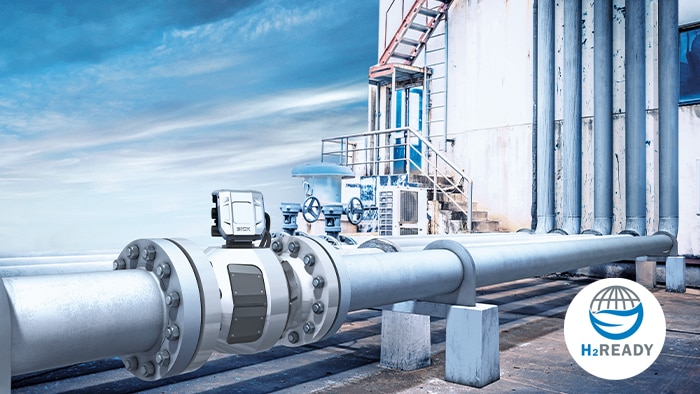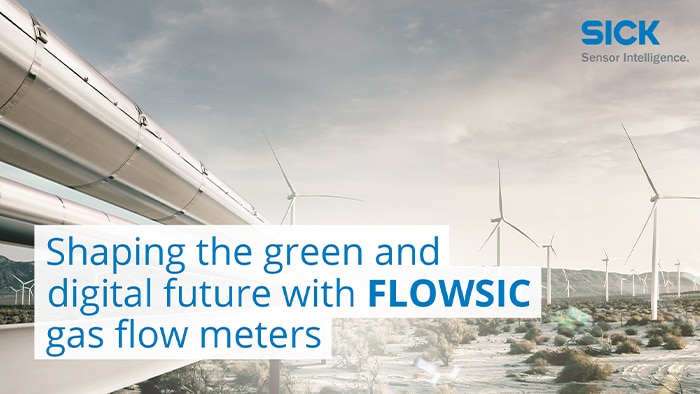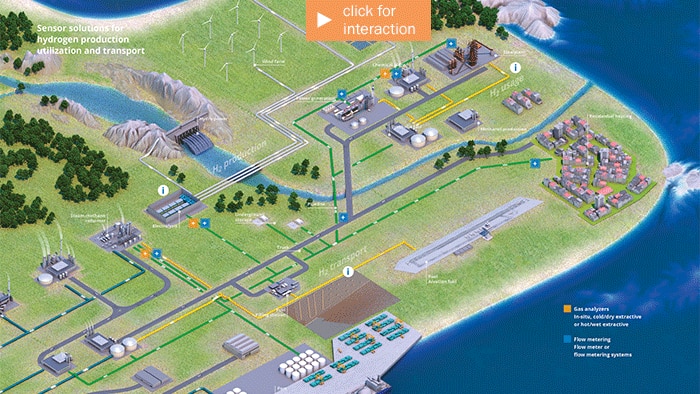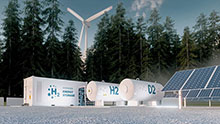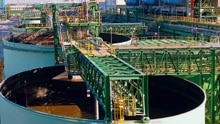SICK ultrasonic flow meters are already capable of reliably metering natural gas / hydrogen blends. The company is working hard on developing a means of metering pure hydrogen in a verifiable manner.
Preparing for the future: Metering hydrogenenriched natural gas and pure hydrogen
Renewable energies have a major role to play in decarbonization. Although natural gas is going to continue to be an important source of energy for many years yet, hydrogen is increasingly gaining traction, especially because it can allow surplus solar and wind energy to be used. The energy crisis that began in 2022 has also presented a financial argument for using hydrogen, because energy costs in general are much higher, while expenditure due to CO2-emissions is making it ever more expensive to use fossil fuels. “Across the board, there is increasing pressure on all players involved in the energy industry to take action more quickly,” says Jörg Wenzel, head of the Marketing unit in the Cleaner Industries cluster at SICK AG.
Pure hydrogen in sight
SICK is a significant step ahead in this respect. Its gas flow meters can already meter natural gas / hydrogen blends, although the addition of hydrogen results in pronounced changes to the properties of the gas, such as density, viscosity, explosivity, flow rates and the speed of sound. “In contrast to many other gas flow meters, the ultrasonic technology in our FLOWSIC devices meters natural gas containing hydrogen just as reliably and stably as natural gas without hydrogen and is capable of compensating for any uncertainty in the measurements,” explains Wenzel. “Our equipment is approved for hydrogen blends of 30%.”
Alongside the addition of hydrogen to the natural gas grid, the use of pure hydrogen is going to become increasingly important in the future. Networks for transporting hydrogen are already in place for industrial purposes. However, if hydrogen is to be used as a source of energy on a larger scale, fiscal metering will be required. Solutions for procedural metering are already available, but they do involve considerably higher tolerances than fiscal metering, which needs to be a lot more accurate. This is a challenge that SICK has been only too happy to take on. We are currently developing special ultrasonic sensors that will be used in future gas meters for fiscal metering of pure hydrogen,” says Wenzel.
There are numerous factors to be taken into account, some of which are still awaiting unequivocal research and definition. For example, hydrogen networks will need to fulfill special requirements that go a lot further than those applicable to the natural gas grid. The highly volatile gas needs special pipelines, compressors, seals and valves. The strictest explosion-proof classification applies, and the flow rate will probably be much higher to compensate for the fact that hydrogen has a lower volumetric heating value than natural gas. “What that means for infrastructure, the components of the grid and thus our metering technology is not entirely clear just yet. However, we do need to consider these factors in our development work,” says Moritz Siegfried, Head of Product Management – Hydrogen.
To make sure that it is up to speed with all the latest trends, SICK is involved in international operational and research projects working on new standards, regulations and certifications relating to hydrogen. For example, it is currently not clear how hydrogen meters are to be calibrated and verified. This is an issue that is of the utmost importance to the metering equipment manufacturer. “Our goal is to play a leading role in this area and to work with other major players to produce answers to these questions,” says Siegfried. In other words, to take a comprehensive and generally farsighted approach – typical SICK, you might say. It is exactly what’s needed as far as the entire team is concerned. “At SICK, we don’t just take a device that we already have and repurpose it for hydrogen. Instead, we develop entirely new equipment, taking all the necessary factors into account,” says Wenzel. The team will not stop at a flow meter, either. “We look at the assignment from all angles and think not in terms of products but in terms of solutions. In addition to verifiable flow metering, determining the purity of hydrogen is important as well,” adds Siegfried. The objective is to launch a system for the fiscal metering of pure hydrogen by 2024.
SICK is part of HyInHeat initiative
SICK is one of 28 members working on the new HyInHeat initiative, which was devised in 2022 and launched in January 2023. The goal of HyInHeat is to establish efficient hydrogen combustion systems for decarbonizing heating and smelting processes in the aluminum and steel industry. This covers the entire process chain, involving designing new furnaces and equipment such as burners or instrumentation and control systems as well as modifying existing ones. The project is being implemented at eight furnaces. It is being coordinated by RWTH Aachen University, and members include ArcelorMittal (one of the world’s largest steel producers), Linde and SSAB. The 48-month project is part of the Processes4Planet Research Association program and is receiving €18 million in funding from the EU.
Interactive graphic: Sensor solutions for clean industries
Momentum: Magazine from the 2022 Annual Report
It is worthwhile to scrutinize success stories for momentum. What was the moment or occasion that set everything rolling and brought success?
The articles in this magazine show that momentum is no coincidence and is more than just a chain of fortunate circumstances. Momentum comes from intuition, inspiration, experience, competence and passion.
